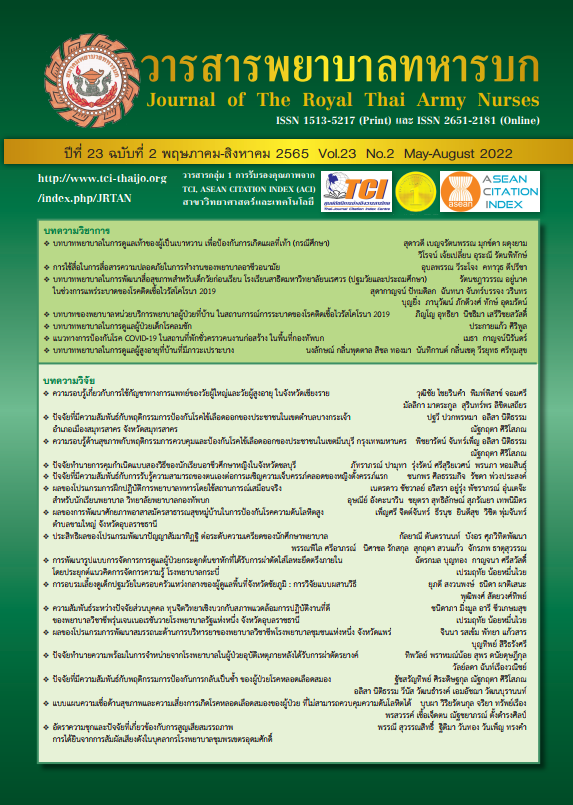Effect of Biocellulose Wound Dressing on Healing of Hard-to-Heal Wounds
Keywords:
biocellulose wound dressing, hard-to-heal wound, wound healing, innovationAbstract
A biocellulose as updated wound dressings is an innovation that has challenged the mission of modern nursing practice to enhance the healing of a chronic hard-to-heal wound. This research aimed to compare the area of chronic hard-to-heal wounds after applying biocellulose wound dressing. The 20 hard-to-heal wounds had cared for at an advanced wound care clinic, one tertiary military hospital, Bangkok, Thailand. Research instruments consisted of 1) a protocol of wound care with biocellulose wound dressing 2) a personal case record form 3) a case record form of hard-to-heal wound characteristics and wound dressing techniques 4) a computer program for image analysis of intractable chronic hard-to-heal wound through mobile phone screen to assess wound size (Tissue Analytic Platform). The results revealed that compared average size of the chronic hard-to-heal wound between 1st week and 2nd, 3rd, and 4th week after applying biocellulose wound dressing, wound size was smaller (mean difference = -0.65, - 0.62, and -2.40), respectively. In addition, average wound size was statistically significant differences (t = -2.90, p < .05) without any complications and allergic reactions. The better wound healing show reddish wound, more moisture, little necrotic tissue and in overall the wounds size were shallower and smaller. In sum, biocellulose wound dressings ought to be an effective wound dressing for hard-to-heal wounds.
Downloads
References
Alexandrescu V. A. Wound Healing - New Insights into Ancient Challenges. London: Intech Open. 2016.
Verdolino DV, Thomason HA, Fotticchia A, & Cartmell S. Wound Dressings: Curbing Inflammation in Chronic Wound Healing. Emerging Topics in Life Sciences. 2021; 5: 523–537.
Punpho K. Model of Wound Care for Patients with Pressure Ulcer. TUH Journal. 2021; 6(3): 43-47. (in Thai).
Vowden P. Hard-To-Heal Wounds Made Easy. Wounds International. 2011; 2(4): 1-6.
Numhom S, Ariyaprayoon P, & Srimuninnimit V. Clinical Evaluation of a New Blue Nano-Silver Biocellulose Ribbon Dressing in Cavity Wounds. Journal of the Medical Association of Thailand. 2017; 100 (Suppl.9): S212-S219.
Prapainop K, & Artsanthia J. Wound Care for Patients in Thailand 4.0 with Nanotechnology. Journal of The Royal Thai Army Nurses. 2017; 18(3): 9-15. (in Thai).
Esa F, Tasirin SM, & Abd Rahman N. Overview of Bacterial Cellulose Production and Application. Agriculture and Agricultural Science Procedia 2. 2014; 113 – 119.
Dwiyana RF, Yogya Y, Gondokaryono SP, & et al. Clinical Efficacy of Biocellulose, Carboxymethyl Cellulose and Normal Saline Dressing in Epidermolysis Bullosa. Journal of Wound Care. 2019; 28(Sup10): S4-S9.
Sampattavanich N, Patrapaisarnsin P, Aunhachoke K. A Randomized, Double-blind, Controlled Trial Comparing the Efficacy of Bacterial Cellulose Impregnated Gauze (BCG) with Conventional Petrolatum Gauze (PG) and 0.5% Chlorhexidine Paraffin Gauze (CPG) as Wound Dressings in Acute Ablative Wound from Carbon Dioxide (CO2) Laser. Division of Dermatology, Department of Medicine, Phramongkutklao Hospital, Bangkok, Thailand. Report. 2017; 1-18.
Chansanti O, & Mongkornwong A. Treating Hard-To-Heal Ulcers: Biocellulose with Nanosilver Compared with Silver Sulfadiazine. Journal of Wound Care. 2020; 29(Sup12): S33-S37.
Napavichayanun S, Amornsudthiwat P, Pienpinijtham P, & Aramwit P. Interaction and Effectiveness of Antimicrobials Along with Healing-Promoting Agents in A Novel Biocellulose Wound Dressing. Materials Science and Engineering: C. 2015; 55: 95-104.
Wongchindaphan S, & Rojhirunsakool S. Wound Dressings in Dermatology. Thai Journal of Dermatology. 2017; 33(2): 135-152. (in Thai).
Tabri F. The Comparison of Biocellulose Wound Dressing and Normal Saline Dressing in The Process of Wound Healing in Mice Skin. International Journal of Medical Reviews and Case Reports. 2019; 3(5): 198-201.
Sood A, Granick MS, & Tomaselli NL. Wound Dressings and Comparative Effectiveness Data. Advances in Wound Care. 2014; 3(8): 511-28.
Metcalf DG, & Bowler PG. Clinical Impact of An Anti-biofilm Hydrofiber Dressing in Hard-To-Heal Wounds Previously Managed with Traditional Antimicrobial Products and Systemic Antibiotics. Burns & Trauma. 2020; 8(4): 1-9.
Leak K, & Johnson S. Going Green: Using A Bio-Cellulose Membrane for Patients with Chronic Non-Healing Wounds. British Journal of Nursing. 2015; 24(20): 1-6.
Savitskaya IS, Shokatayeva DH, KistaubayevaL AS, Ignatova IV, & Digel IE. Antimicrobial and Wound Healing Properties of A Bacterial Cellulose-Based Material Containing B. Subtilis Cells. Hyliyon. 2019; 5: 1-11.
Net Health Systems, Inc. Net Health’s Tissue Analytics for Wound Care Granted Breakthrough Device Status by FDA. Pittsburgh: 2022.
Downloads
Published
How to Cite
Issue
Section
License
Copyright (c) 2022 Journal of The Royal Thai Army Nurses

This work is licensed under a Creative Commons Attribution-NonCommercial-NoDerivatives 4.0 International License.
บทความหรือข้อคิดเห็นใดใดที่ปรากฏในวารสารพยาบาลทหารบกเป็นวรรณกรรมของผู้เขียน ซึ่งบรรณาธิการหรือสมาคมพยาบาลทหารบก ไม่จำเป็นต้องเห็นด้วย
บทความที่ได้รับการตีพิมพ์เป็นลิขสิทธิ์ของวารสารพยาบาลทหารบก
The ideas and opinions expressed in the Journal of The Royal Thai Army Nurses are those of the authors and not necessarily those
of the editor or Royal Thai Army Nurses Association.






